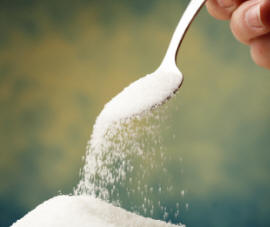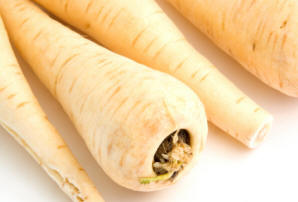Winter 2009: To Your Health
In this Issue:
- Hot Beverages to Warm You Up This Winter…Without All the Fat!
- Boost Your Energy and Fight the Winter Blues
- Set Yourself Up For Success and Start Fresh in 2010
- Limit Added Sugars- Your Heart Will Thank You!
- Give Your Sweetie the Gift of Heart Health This Valentine’s Day
- Feature Food of the Month: Parsnips
- Feature Food of the Month Recipe: Parsnips with Sautéed Onions
Hot Beverages to Warm You Up This Winter…Without All the Fat!

It’s hard to imagine a better way to wind down a long, blustery winter day than with a warm blanket, a great book or movie, and a steaming mug of your favorite hot beverage. Conveniently, many of the most popular winter drinks are loaded with antioxidants- substances that prevent free radicals from damaging body cells! While these drinks have some great benefits, baristas everywhere are loading them with tons of fat and calories in the form of sugary syrups, whipped cream, and full fat milk…so be careful! Keep reading to see what your favorite winter drink can do for you…
Coffee- Need that morning cup o’ Joe to get your day started? Research touts coffee as the most prominent source of antioxidants in the American diet, based on antioxidant levels per serving size and frequency of coffee consumption. Both regular and decaffeinated coffees appear to have similar antioxidant levels. Moderation, of course, is key…so don’t go coffee crazy! Consuming one to two cups a day appears to have benefits including protecting against liver and colon cancer, type 2 diabetes and Parkinson’s disease.
Tea- Whether you like black tea or green tea, research shows that both types can have a positive effect on your body! Tea is an abundant source of flavonoids, a particular type of antioxidant. Flavonoids have a detoxifying affect that fights free radicals, whose damage can lead to formation of blood clots, hardening of the arteries, and cancer. Laboratory tests even suggest that green and black tea may aid in boosting metabolism, block allergic response, slow the growth of tumors, protect bones, improve skin and even slow the onset of diabetes. Think about it…people in China and Japan, where tea is consumed in large amounts, have a much less incidence of heart disease and certain cancers than people in the Western world. Keep in mind that tea is almost calorie-free, so swapping soda or juice for a cup of tea will cut out a significant amount of calories weekly!
Hot Cocoa- Not all hot cocoas are created equal! If you want to get a dose of antioxidants, be sure to make your hot chocolate with dark chocolate that is at least 70% cocoa or look for cocoa mixes that list dark chocolate as the first ingredient. To cut unnecessary fat and calories, make it with low-fat or skim milk. The bonus from dark chocolate is a type of antioxidant called catechins which may help prevent disease and bolster the immune system.
Mulled Wine- Research supports the power of flavonoids and resveratrol found in grapes and red wine. These substances have anti-inflammatory qualities that may help slow the progression of Alzheimer’s disease and lower one’s risk of developing macular degeneration. Macular degeneration is the leading cause of blindness in people over the age of 55. Always remember to drink alcohol in moderation and have a designated driver!
Apple Cider with Cinnamon- Apples and cinnamon both pack a powerful nutritional punch. Quercetin, a nutrient found in apples, acts as an antioxidant to protect brain cells from damage that may trigger neurological disorders like Alzheimer’s and Parkinson’s. Other phytonutrients in apples may be protective against heart disease, colon cancer and diabetes. As if that wasn’t enough, add cinnamon to your cider and you have even more benefits! Research has shown cinnamon to improve blood sugar and cholesterol levels! For safety, always be sure to check that your cider is pasteurized.
While you’re aware of the impact that coffee house drinks have on your wallet, are you aware of how many calories your habit is “costing” you?
Here’s a handy guide to fill you in…
| Brewed Coffee, black | 5 calories |
| Caffe Latte, whole milk | 220 calories |
| Caffe Latte, skim milk | 130 calories |
| Caramel Macchiato, whole milk | 270 calories |
| Pumpkin Spice Latte, whole milk, whipped cream | 410 calories |
| Pumpkin Spice Latte, skim milk, no whipped cream | 260 calories |
| Signature Hot Chocolate, skim milk, whipped cream | 490 calories |
| Signature Hot Chocolate, skim milk, no whipped cream | 410 calories |
| Tazo Tea, hot, any flavor | 0 calories |
| Tazo Green Tea Latte, whole milk | 390 calories |
| Tazo Green Tea Latte, skim milk | 290 calories |
*Based on 16 oz. size
Reference: American Chemical Society
Click here for tips on enjoying the warmth of winter beverages while watching your waistline!
Boost Your Energy and Fight the Winter Blues

Despite the unmistakable beauty of the first white snowfall, the seemingly long winter months often leave people feeling rather blue. As the days become shorter and the weather gets colder it is tempting to fall into “hibernation” mode. While it’s okay to sleep a little later on your days off, do not let the seasonal blues get the best of you! Read on and discover simple ingredients to add to your meal plan to keep your energy level up all holiday season long.
Complex Carbohydrates
Whole grains are the way to go! Complex carbohydrates found in whole grains are absorbed slowly by the body, keeping blood sugar levels from spiking and in turn, providing the body with a steady stream of energy throughout the day. They are also a rich source of B-vitamins that are shown to boost energy! Reach for whole grain products such as whole wheat bread, brown rice, whole grain pasta, and oatmeal.
Fiber
Fiber helps to prevent constipation which can leave you feeling bloated and sluggish. It also slows the digestion process, thereby promoting a feeling of fullness. In addition to whole grains, fiber can be found in many fruits and vegetables, including dark leafy greens, broccoli, cauliflower, and many different types of beans.
Protein and Iron
Protein is an important macronutrient that maintains muscle mass, as well as boosts chemicals in the brain that increase energy and mental focus. Good sources of protein include lean meat and poultry, low-fat dairy, legumes, soy and eggs. Many protein sources, especially lean red meat, are rich in iron as well. Low iron levels, also known as anemia, may result in fatigue. For those who do not eat red meat, whole grains, nuts, seeds, prunes, beans, spinach and raisins are also high in iron.
Fluids
Do not underestimate the power of water. Just a slight dehydration can drain the body of energy and result in feelings of fatigue. Six to eight glasses of water a day will battle dehydration, and those who exercise should drink a minimum of eight glasses to counteract the fluid loss from sweating. If you drink alcohol, do so only in moderation. Alcohol dehydrates the body, disrupts sleep patterns and can cause vitamin B deficiencies.
While the foods you eat are important factors for keeping your energy level up, there are several other lifestyle factors that play key roles in fighting fatigue not only in the winter, but all year long. Click here to find out what they are!
Set Yourself Up For Success and Start Fresh in 2010

As New Year’s Day looms near, many people desire to make positive changes for the year to come. Unfortunately, making a New Years Resolution is often easier said than done. Do you find yourself starting strong and quickly losing sight of your goal not long after you began? When this happens it is common to feel a little bit discouraged and down on yourself…but don’t let it hinder your ability to keep trying!
The first step to get on track is to recognize that self-change is one of the most difficult things a person can do. Chances are the journey will not be an easy one, but change is not impossible. To set yourself up for success, strive for a realistic goal that is measurable and has personal meaning to you. Then, to successfully enact change and reach that goal, you must know every small detail as to how you will get there. Start with questions that are as basic as basic gets! What exactly are you going to do, how are you going to do it, and at what time? When you have those details ironed out, structure your personal environment to facilitate, rather than sabotage, your goal. If your goal is to incorporate more fruits and vegetables into your meal plan, have clean and prepped snacks like baby carrots, celery sticks, cucumber slices, and whole fresh fruit ready to go in plain sight in the fridge. You could also try having your spouse or kids hide the trigger foods that cause you to overeat.
Always keep in mind that a little slip-up will inevitably occur from time to time. Cut yourself some slack and do not fall victim to what is called the “what-the-heck effect.” The “what-the-heck effect” is when you have, for example, that one scoop of ice cream you’ve been craving. That one scoop turns into two…and before you know it you say to yourself “oh, what the heck!” and devour the entire pint. It’s generally a downward spiral from there and soon enough you’ve abandoned your goal altogether. Have one scoop of ice cream, put the pint back in the freezer, put your bowl and spoon in the sink and move on!
Hoping to finally lose the extra weight you’ve been carrying around? Click here to learn helpful hints for keeping it off for good!
Then contact Bonnie R. Giller at 516-486-4569 for help in keeping those New Year’s Resolutions.
Limit Added Sugars – Your Heart Will Thank You!

The American diet is notorious for its abundance of added sugar, with soft drinks and other sugar-sweetened beverages as the number one culprit. Added sugars are those that are added to foods during processing or preparation, as well as at the kitchen table. While sugar is naturally occurring in food, it’s the high intake of these added sugars that has been linked with a marked rise in obesity. The added sugar is also associated with inflammation, and an increased risk of high blood pressure and high triglyceride levels, two risk factors for heart disease and stroke.
Sugar provides what are known as empty calories. This means that sugar contains no nutritional value other than the calories it supplies. When a diet contains excessive amounts of foods and beverages with added sugars, more nutritious foods are displaced. To ensure a balanced intake of nutrients and to limit excess calories, it is important to be sure that foods high in added sugars are not taking the place of foods that contain essential nutrients your body needs.
This is where discretionary calories come in. Discretionary calories is the amount of calories “left-over” after a person consumes the recommended foods and nutrients to meet his or her personal nutrient requirements. Foods that contain added sugars and solid fats, as well as alcoholic beverages are considered discretionary calories and should only be included in one’s meal plan after meeting nutrient requirements from foods like fruit, vegetables, low-fat dairy products, whole grains, lean meats, poultry and fish. The American Heart Association now recommends that no more than half of one’s daily discretionary calorie allotment should come from added sugars.
Recent research presented at The American Heart Association’s 63rd High Blood Pressure Research Conference found that men who consumed a high fructose diet for just two weeks experienced a rise in overall blood pressure. Fructose is one of the dietary sugars. It makes up half of the sugar in table sugar and high-fructose corn syrup. The study followed 74 men of an average age of 51 years old. In addition to their usual diet, the men consumed an extra 200 grams of fructose per day. At the end of only two weeks, the group experienced an average rise of about 6 mmHg in systolic blood pressure and about 3 mmHg in diastolic blood pressure. This research, in combination with other studies, has spurred The American Heart Association to expand on previous recommendations and provide consumers with more specific information on added-sugars intake.
References: 1. The American Heart Association 2. Medical News Today
Click here to find out the new American Heart Association recommendations for added sugar for men and women!
Give Your Sweetie the Gift of Heart Health This Valentine’s Day

Happy Valentine’s Day!
There’s nothing quite as sweet as giving or receiving a bouquet of roses and a heart-shaped box of chocolates on Valentine’s Day. This February, skip the milk chocolate and head straight for luscious dark chocolate!
So what is it that makes dark chocolate triumphant over milk chocolate? It’s all in the antioxidants…flavonoids in particular! Flavonoids are naturally-occurring compounds found in plant-based foods that are recognized for exuding certain health benefits including reducing platelet aggregation, affecting the ability of blood vessels to relax, and positively affecting the balance of certain hormone-like compounds that play a role in heart health.
These flavonoids provide cocoa with a naturally strong and pungent taste. To make our favorite chocolate products, the cocoa undergoes several processing steps to reduce the bitterness that many people find unpleasant. Chocolate that is processed the most contains the least amount of flavonoids, and therefore has the least benefits. Dark chocolate undergoes less processing and appears to retain the greatest amount of flavonoids.
Research conducted in Germany and published in The Journal of the American Medical Association reveals that dark chocolate appears to reduce blood pressure in those with mild hypertension. The study involved six men and seven women with an average blood pressure of 153/84 mmHg. Half of the participants ate a 100 gram dark chocolate candy bar every day for two weeks. The other half of participants ate a 100 gram white chocolate candy bar for the same amount of time. They were all asked to balance the candy bar’s 480 calories by avoiding other foods with similar calories and nutrients. Upon completion of the two-week period, those who consumed dark chocolate had an average drop of 5 points in systolic blood pressure, and 2 points in diastolic blood pressure. Those who ate white chocolate did not experience any reduction.
Although this is great news, it does not mean that you can eat as much dark chocolate as you’d like! All chocolate contains fat and calories and must be incorporated into a balanced meal plan. Because there is no serving size of dark chocolate established to reap the heart healthy benefits, speak with your doctor or registered dietitian to find out the best way to incorporate a small amount of the treat into your meal plan. Keep in mind that other foods like apples, tea, red wine, and cranberries are also rich in flavonoids…so be sure eat these as well!
If you’re trying to win the heart of someone special this Valentine’s Day, reach for a box of flavonoid-rich dark chocolate. Your sweetheart will thank you for it!
Click here for more healthy recipes!
Feature Food of the Month: Parsnips

History
In ancient Rome, parsnips were considered a food of luxury, and were prized for their long shelf-life, sweet and nutty flavor, and nutritional value. The Europeans brought parsnips to America in the 16th century but they never caught on quite as much as their cousin, the carrot. These days, the potato has pushed parsnips out of the way, taking over as a major source of starch in the American diet.
Selection
You can find parsnips all year long, but they are better harvested in the late fall, winter, or early spring when the ground is still frozen. This is because the sugars in a parsnip do not develop until the first frost.
Choose parsnips that are small to medium in size, about 5-10 inches in length. While parsnips can grow very large, they are less desirable because they contain a bitter, woody core. Select parsnips that have firm flesh without any soft spots. Flesh should be even in color, as dark spots can indicate freeze-burn or decay.
Storage
Store parsnips in a cool, dark place. They should last up to 2 weeks, if not longer, wrapped in a paper towel and placed in a plastic bag in the vegetable drawer of your refrigerator. Use cooked parsnips that have been refrigerated within 3 days.
If you’d like to freeze parsnips for later use, cut them into ½ inch cubes and par-boil or steam for up to 5 minutes. Pack into containers, allow to cool, and then freeze. Use frozen parsnips within 8 to 10 months.
Cooking
Parsnips are best enjoyed cooked. They are the sweetest when cooked just until tender, so avoid overcooking whenever possible. They do need to be peeled, so many prefer cooking the parsnip first and then scraping off the skin after. Doing so will help retain nutrients during the cooking process. Depending on individual preference, parsnips may be roasted, or even steamed and pureed like mashed potatoes. Herbs such as basil, thyme, dill, and tarragon compliment parsnips very well.
Healthy Recipe: Parsnips with Sautéed Onions
Ingredients:
2 tsp. olive oil
4 onions, thinly sliced (about 4 cups)
1 tbsp. dried thyme
½ tsp. salt
1/8 tsp. black pepper
1½ lbs. parsnips, peeled and thinly sliced (about 8 parsnips)
1 cup reduced sodium chicken or vegetable broth
Instructions:
- Preheat oven to 400° F. Coat a 1½ quart shallow baking dish with cooking spray.
- Heat oil in a large nonstick skillet over medium-high heat. Add onions and cook, stirring frequently, until golden, 8-10 minutes. Add thyme, salt and pepper; remove from heat.
- Spread half the parsnips in the prepared dish. Cover with onions. Top with the remaining parsnips and pour in broth. Tightly cover the dish with aluminum foil and bake until the parsnips are very tender, about 1 hour.
- Remove from the oven. Set the oven to broil. Uncover the dish and baste the top with juices. Broil until the top begins to brown, 3-4 minutes.
Yield: 8 servings
Serving Size: 1 cup
Exchanges: 1 starch, 1½ vegetable
Nutrition Facts
Calories: 107
Total Fat: 1.5 grams
Saturated Fat: 0 grams
Polyunsaturated Fat: 0 grams
Monounsaturated Fat: 1 gram
Cholesterol: 0 milligrams
Protein: 2 grams
Carbohydrate: 23 grams
Sodium: 209 milligrams
Dietary Fiber: 5 grams
Click here for more healthy recipes!

Leave a Reply
Want to join the discussion?Feel free to contribute!